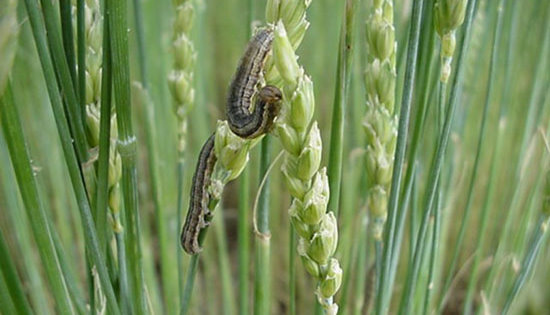
Agricultural News
Dr. Royer Recommends Farmers Watch for Army Worms in Wheat
Fri, 22 May 2015 11:56:43 CDT
 Oklahoma State University Extension Entomologist Dr. Tom Royer has written a blog about armyworms in wheat.
Oklahoma State University Extension Entomologist Dr. Tom Royer has written a blog about armyworms in wheat.
We have a late-maturing wheat crop that finally received some needed rain. I received a report of armyworms infesting wheat in the Vernon, Texas area. Armyworm infestations typically occur in late April through the first two weeks of May, but the cooler spring we are experiencing this year may have delayed their development.
Armyworm infestations occur more frequently around waterways, areas of lush growth, or areas with lodged plants. These areas should be checked first to determine the size of the infestation.
Early signs of an infestation include leaves with ragged margins that have been chewed. You may find "frass" i.e. the excrement from armyworm caterpillars, around the base of wheat stems. They also tend to clip heads from developing wheat plants. The head clipping I have noticed over the years us usually restricted to secondary tillers with very small, green heads that would not likely contribute much to yield.
Scout for armyworms, at 5 or more locations looking for "curled up worms". Armyworm caterpillars tend to feed at night, so a good strategy is to bring a flashlight and look at fields after dusk when they are feeding up on the plant stems. The suggested treatment threshold for armyworms is 4-5 unparasitized caterpillars per linear foot of row.
Armyworms have a number of natural enemies that help keep populations in check, if given a chance. In particular, parasitic wasps and flies attack them. If you find small white cocoons littered on the ground that are about ¾ the size of a cue tip, the natural enemies have already taken care of the problem.
If wheat is past the soft dough stage, control is not warranted unless obvious head clipping can be seen and caterpillars are still present and feeding. Worms feeding on the awns when plants are past soft dough will not cause enough yield loss to justify the expense of an insecticide application that is solely intended for armyworm control. When choosing to spray, keep in mind that some insecticides require a 30 day waiting period for harvest.
Consult CR-7194 Management of Insect and Mite Pests of Small Grains for information on insecticides registered for control of armyworms. Click here for the PDF.
For more information on this topic, contact Tom A. Royer, Extension Entomologist at tom.royer@okstate.edu
WebReadyTM Powered by WireReady® NSI
Top Agricultural News
More Headlines...




















